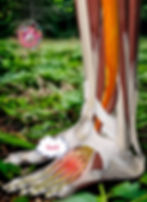Understanding Foot Extensor Tendinopathy: A Guide for Runners by a novice Cardiff runner!
- Matthew Corbin D.C
- Apr 22, 2024
- 4 min read
Updated: Feb 1

I'm going to be selfish and talk about me again. Why? Because it's still a relevant chiropractic and sports issue, that many can gain an insight and solution, for this painful issue.
Ive struggled to find the right trainers for running which is more the frustrating, because i really enjoy it. Ive been for gait analysis and have been given the "right" shoes for my gait. Three runs later i had shin splints. I went back to my older pair which work well for me and haven't had any issues with. I recently bought a new pair and after around 5 runs I have foot extensor tendinopathy. This time I'm pretty sure the shoes were too tight. I was upping my training with a running partner and I probably got carried away and increased my mileage too quickly. They say we should not increase distance more than 10% each week. Well, i went way past that (silly me). We live and learn! For this blog I have made a quick and easy to follow video for foot extensor tendinopathy self care also. I'm 2 weeks into this injury and I'm glad to say I can walk with no pain now. But running can still aggravate it, as i found out yesterday (so i stopped). I'll keep up my rehab and try again in a week. Number 1 rule, never train through pain. Always work around it ;)
Let's dive into this annoying affliction.
What is Foot Extensor Tendinopathy?
Foot extensor tendinopathy is a condition that results from the inflammation or degeneration of the extensor tendons, which run along the top of the foot. These tendons are crucial for lifting the foot during walking and running, making them especially important for athletes and active individuals. The condition is characterized by pain and swelling on the top of the foot, and can range from mild discomfort to severe pain that affects mobility. For me it's been all of the above. Even just putting a shoe on was extremely painful.

What are the causes and Risk Factors of Foot extensor Tendinopathy?
The primary cause of extensor tendinopathy is overuse, particularly through repetitive activities such as running or jumping. Factors that can increase the risk of developing this condition include wearing poorly fitting or tight shoes, sudden changes in training intensity, especially when running uphill, and improper running techniques. Additionally, muscle tightness or weakness and foot posture issues like flat feet or high arches can also contribute to the development of tendinopathy. That's why it's so important to perform strength and stability training to avoid running injuries.
What are the Signs and Symptoms of Foot extensor Tendinopathy?
Individuals with foot extensor tendinopathy typically experience aching or sharp pain on the top of the foot, which can worsen with exercise and may be accompanied by swelling. The pain may also intensify when curling the toes or during activities that stretch the tendons. Over time, symptoms can progress, leading to increased foot weakness and stiffness if left untreated and not managed. Continuous running with this injury is a definite no no.
Recovery and Management
Recovery time can vary widely depending on the severity of the tendinopathy and the effectiveness of treatment. Mild cases might improve within a few weeks, while more severe cases could take several months to heal fully. Key management strategies include rest, ice application to reduce inflammation, elevation of the foot, and the use of compression bandages or sleeves to support the foot and reduce swelling. It is also important to address any contributing factors such as footwear or training habits to prevent recurrence. In my case getting the right pair of trainers. Many will be OK with a crosse trainer of bike to keep up their cardio. But if anything causes pain it's best to leave it for the moment. Always work around it and not through it.
The following are some nice and easy home care to reduce pain, increase flexibility and speed up the healing process.
Chiropractic Care and Rehabilitation
Chiropractic care can be beneficial for managing foot extensor tendinopathy, particularly through techniques that address joint alignment and improve foot mechanics. Chiropractors may also recommend specific exercises to strengthen the foot and lower leg muscles, thereby supporting the healing tendons and preventing future injuries. These exercises often focus on stretching the calf muscles and strengthening the muscles that support dorsiflexion of the foot.

For runners and athletes, adapting training routines to include adequate rest periods and varying the types of surfaces run on can also help manage and prevent extensor tendinopathy. Ensuring proper footwear that fits well and provides adequate support is crucial.
For more detailed guidance on managing foot extensor tendinopathy, including specific exercises and chiropractic techniques, consider consulting with a healthcare professional who specializes in sports injuries and musculoskeletal health. In rare cases a fracture can be the culprit. Another reason to seek a professional.
I myself have treated this on my patients many times with great success. Bookings can be made via my main site www.corbinchiropractic.co.uk
I wish you luck! Although it just takes a little time and knowhow.

.png)
